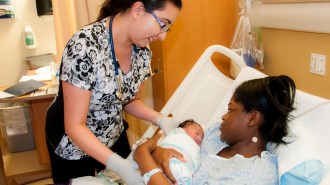Chicken poses significant drug-resistant Salmonella threat
Pennsylvania prevalence numbers prove troubling
More than one-in-five retail samples of raw chicken cutlets collected in Pennsylvania hosted Salmonella, a new study found — twice the national average reported in a 2007 U.S. Food and Drug Administration survey. And where these bacteria were present, more than half were immune to the germicidal activity of at least one antibiotic. Nearly one-third were resistant to three or more drugs.

The good news: The Pennsylvania stats are lower than the chicken contamination rates seen in earlier studies involving other, admittedly less virulent food poisoning agents, such as Enterococcus faecalis. What the new data do point out is that rates of foodborne bacteria can be high, if regionally variable. They also point to the wisdom of cooks adopting the precautionary principle: assuming that all the chicken that enters their kitchens is bugged.
Epidemiologist Nkuchia M. M’ikanatha of the Pennsylvania Department of Health in Harrisburg and his colleagues collected 378 chicken cutlets from grocery stores and farmers’ markets throughout central Pennsylvania for a year. Some of the meat had been laying open, on display, in the butcher’s case; others had come prepackaged. Some had been labeled organic and a few carried designations that the meat came from animals raised without use of growth-promoting antibiotics.
Regardless of how the animals had been reared or what kind of outlet had sold the meat, all sources of chicken were equally likely to be contaminated, the researchers report in the August Foodborne Pathogens and Disease. Indeed, “One of the six samples with an antibiotic-free claim was resistant to at least three antibiotics,” notes M’ikanatha’s team (which includes representatives of six state and federal agencies, the University of Pennsylvania and another research organization).
Although there is an arsenal of drugs available to fight Salmonella infections, one of more of those drugs may not work if the germs are resistant to them. And the source of many drug-resistant germs: the barnyard.
In the new study, 43 percent of tainted chicken hosted Salmonella immune to ceftiofur, an antibiotic approved for use on chickens as young as one-day old. That incidence rate is particularly disturbing, M’ikanatha’s group points out, because resistance to this drug “correlates with decreased susceptibility to other extended-spectrum cephalosporins [antibiotics], including ceftriaxone, a drug of choice for treatment of severe salmonellosis in humans, particularly in children where therapeutic options are limited.” Between 1996 and 2006, CDC charted a 17-fold increase in resistance to these ESC antibiotics.
The new Pennsylvania paper points to why there’s growing concern within the public-health community about the widespread prophylactic use of low-dose antibiotics in livestock.
And the lesson for consumers: We must assume that all raw meat is teeming with dangerous germs. That means handwashing — with plenty of soap — must become automatic every time we touch meat, touch a surface in the kitchen that has had contact with raw meat (from cutting boards and knives to countertops) or touch something that might have been used to cleanse germy surfaces (such as sponges and towels).







